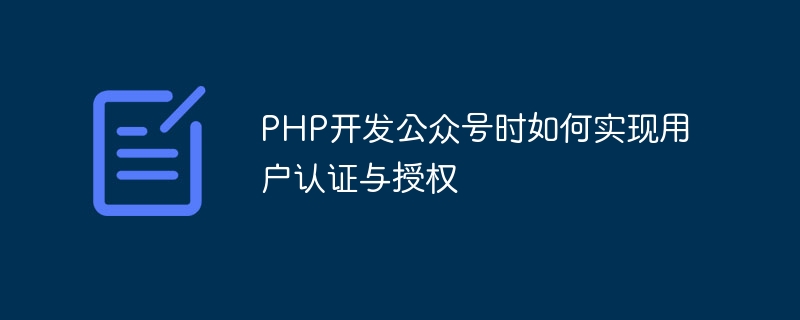Home >Backend Development >PHP Tutorial >How to implement user authentication and authorization when developing public accounts in PHP
How to implement user authentication and authorization when developing public accounts in PHP
- WBOYWBOYWBOYWBOYWBOYWBOYWBOYWBOYWBOYWBOYWBOYWBOYWBOriginal
- 2023-09-21 11:51:291063browse

How to implement user authentication and authorization when developing public accounts in PHP
With the popularity of smartphones and social media, public accounts have become an important means of communication between enterprises and users important tool. In order to ensure the security of user information, user authentication and authorization functions need to be implemented when developing public accounts. This article will introduce in detail how to use PHP to develop public account user authentication and authorization, and provide specific code examples.
1. User Authentication
User authentication refers to the process of verifying user identity for public accounts, which is generally divided into three steps: user authorization, obtaining authorization credentials and verifying authorization credentials.
- User Authorization
User authorization means that the user agrees to provide his or her personal information to the official account. During development, the OAuth2.0 protocol provided by the WeChat open platform can be used for user authorization.
Sample code:
$redirect_uri = urlencode("http://example.com/callback.php"); // 回调URL
$scope = "snsapi_userinfo"; // 用户授权的作用域
$authorize_url = "https://open.weixin.qq.com/connect/oauth2/authorize";
$appid = "your_appid"; // 公众号的appid
$authorize_url .= "?appid=" . $appid . "&redirect_uri=" . $redirect_uri . "&response_type=code&scope=" . $scope . "&state=STATE#wechat_redirect";
header("Location: " . $authorize_url);- Get authorization credentials
After the user agrees to the authorization, the official account will redirect to the specified callback URL and carry a Temporary authorization credential code. In the page of the callback URL, the user's authorization credential access_token can be obtained through this code.
Sample code:
$code = $_GET['code']; $access_token_url = "https://api.weixin.qq.com/sns/oauth2/access_token"; $appid = "your_appid"; $secret = "your_secret"; $access_token_url .= "?appid=" . $appid . "&secret=" . $secret . "&code=" . $code . "&grant_type=authorization_code"; $response = file_get_contents($access_token_url); $result = json_decode($response, true); $access_token = $result['access_token']; $openid = $result['openid'];
- Verify authorization credentials
After obtaining the user's authorization credentials, you can verify by calling the interface provided by the WeChat open platform Whether the authorization credentials are valid.
Sample code:
$check_token_url = "https://api.weixin.qq.com/sns/auth";
$check_token_url .= "?access_token=" . $access_token . "&openid=" . $openid;
$response = file_get_contents($check_token_url);
$result = json_decode($response, true);
if ($result['errcode'] == 0) {
// 授权凭证有效
// 进行其他操作,例如获取用户信息等
} else {
// 授权凭证无效
// 进行处理
}2. User authorization
User authorization refers to the steps to obtain user detailed information based on user authentication. Using the obtained access_token and openid, the user's detailed information can be obtained by calling the interface provided by the WeChat open platform.
Sample code:
$userinfo_url = "https://api.weixin.qq.com/sns/userinfo"; $userinfo_url .= "?access_token=" . $access_token . "&openid=" . $openid; $response = file_get_contents($userinfo_url); $result = json_decode($response, true); $nickname = $result['nickname']; $sex = $result['sex']; $province = $result['province']; $city = $result['city']; $headimgurl = $result['headimgurl'];
The above are all the steps to implement user authentication and authorization when using PHP to develop public accounts. Through the above sample code, functions such as user identity verification and obtaining user details can be implemented in the public account to ensure the security and reliability of user information. I hope this article will be helpful to developers who develop public accounts.
The above is the detailed content of How to implement user authentication and authorization when developing public accounts in PHP. For more information, please follow other related articles on the PHP Chinese website!
Related articles
See more- WeChat mini program mall development uses WeChat authorization and implements the page code of the personal center
- What do you need to learn to do game development?
- What do you need to learn about back-end development?
- What is the website development process
- How to develop a mini game in WeChat mini program? (Practical tutorial)

